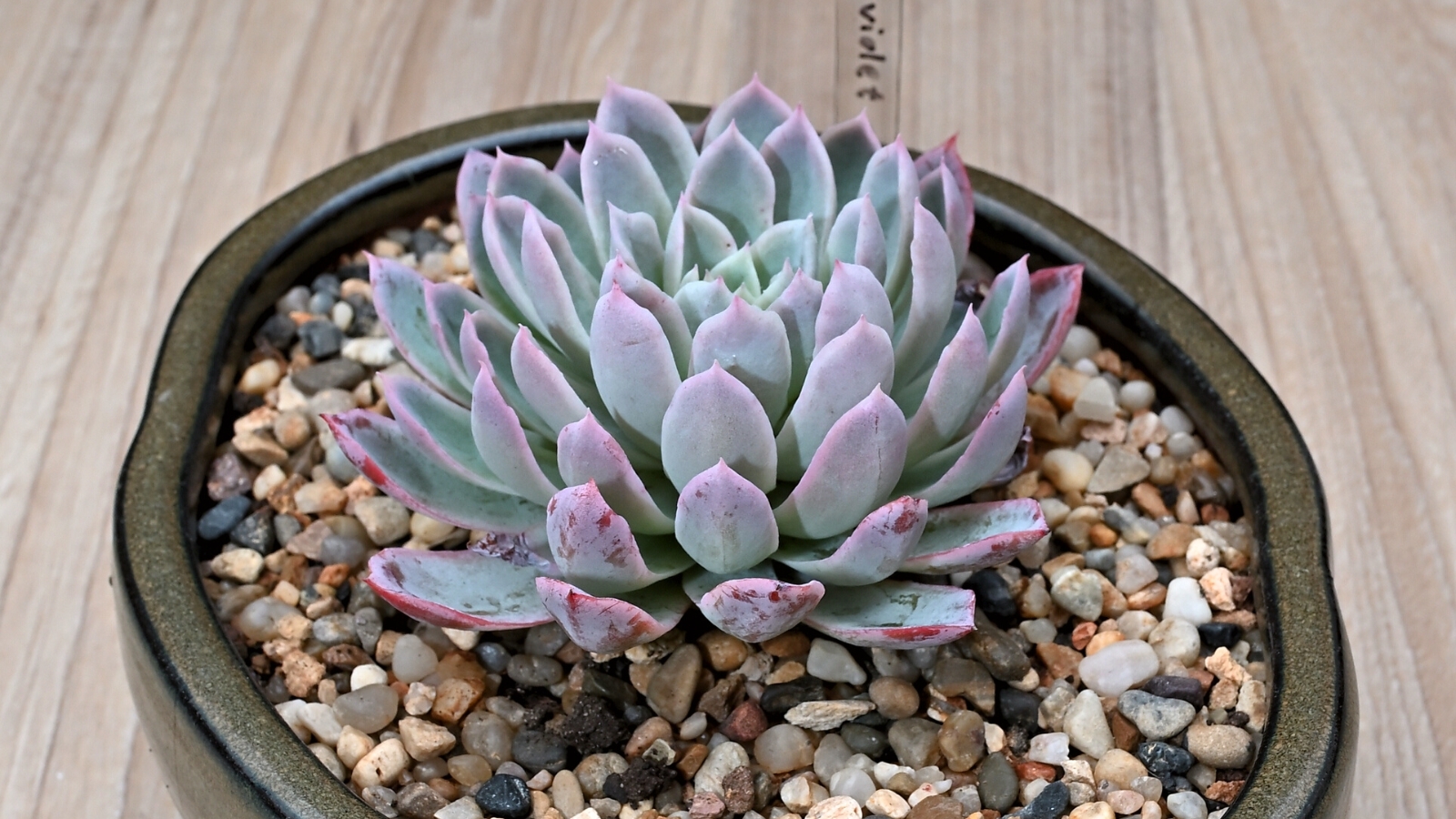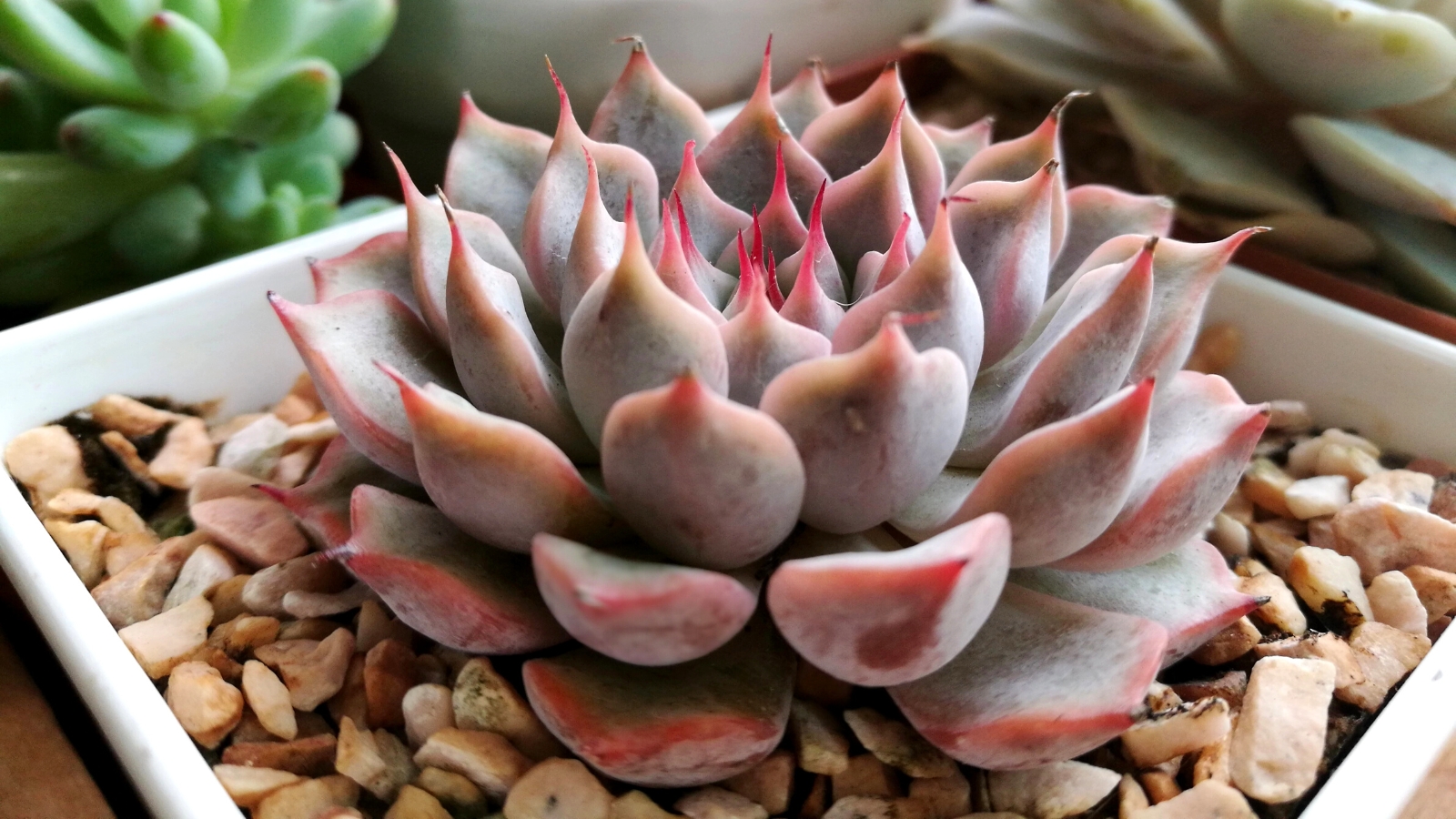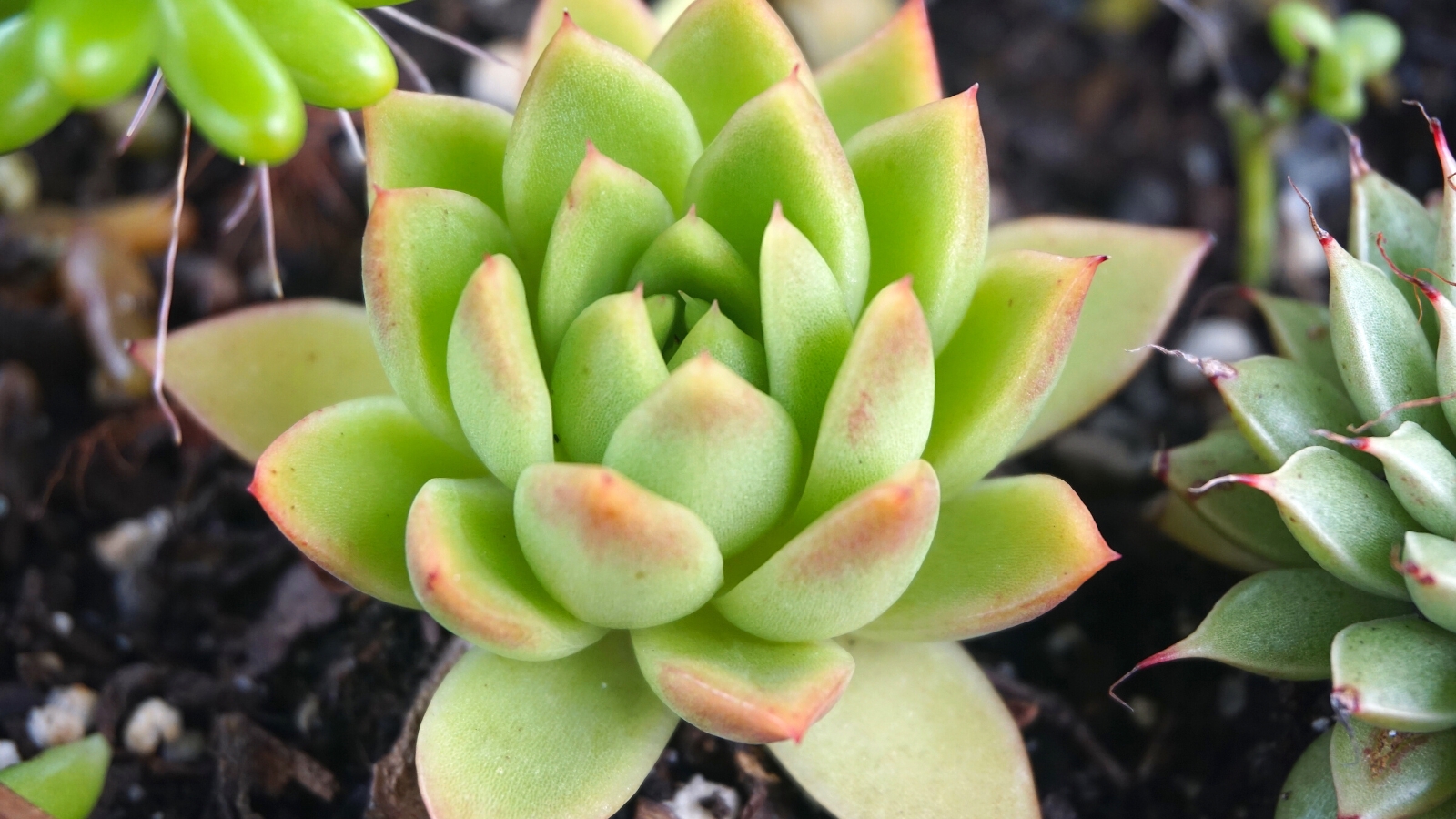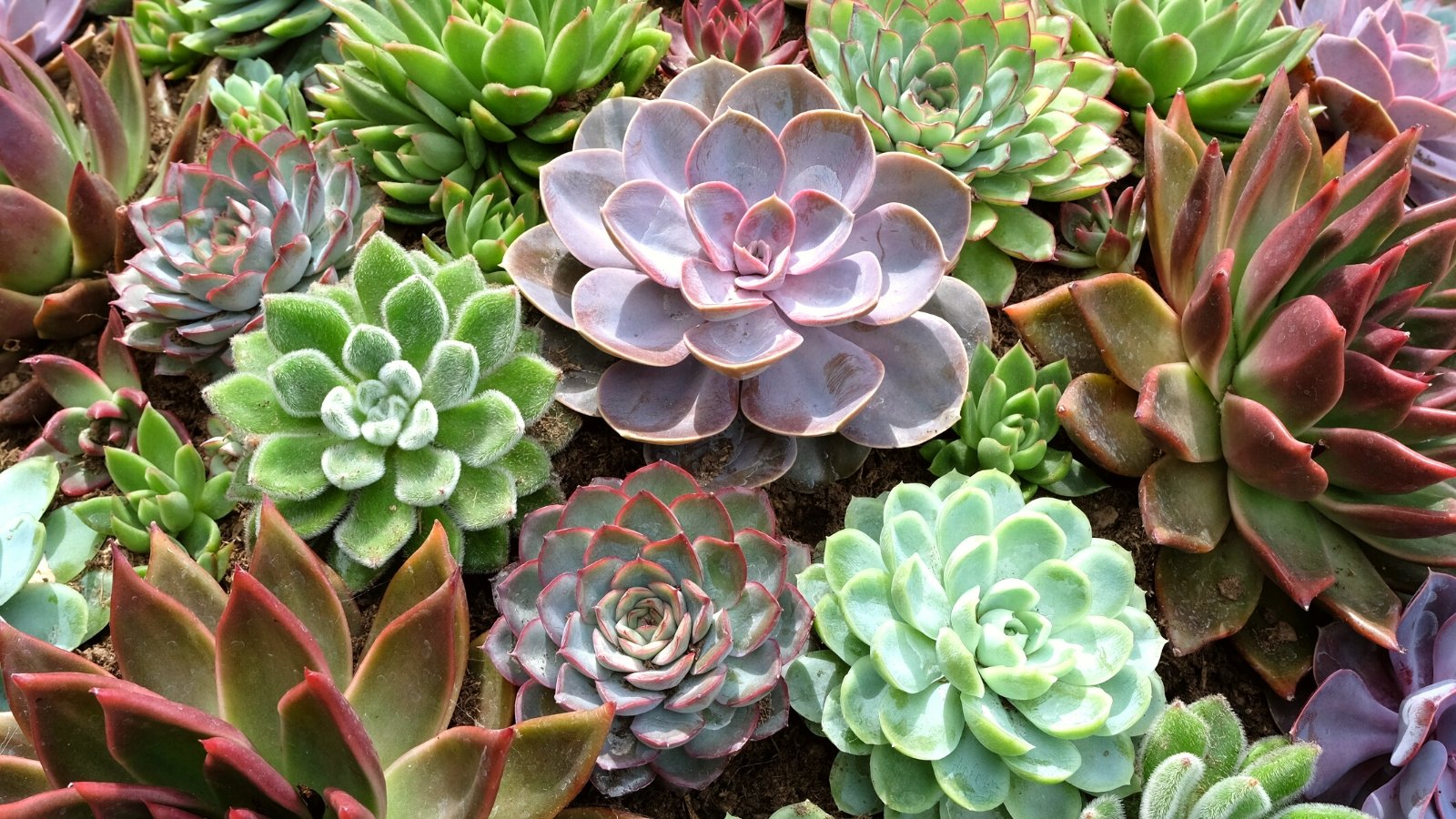Echeverias are satisfying and easy-to-maintain succulent crops. They’re versatile and don’t require a lot from their householders. These satisfying little crops like to vary colours when fortunately careworn from chilly or direct picture voltaic publicity. Most produce good flowers all by means of the summer season season months, as appropriately. They’re terribly resilient and simple to propagate.
In case you need to add some echeverias to your succulent yard or assortment, there’s all kinds to pick from. They arrive in a variety of colours, together with completely completely totally different leaf shapes and orientations.
All it is advisable to comprehend success with these crops is a sunny window and a few well-draining soil. Listed beneath are a variety of of my favourite sorts of echeveria which will work good in your succulent yard.
Perle von Nurnberg


‘Perle von Nurnberg’ might be going one in every of many hottest sorts of echeveria. Florists love this cultivar for its delicate, gray-blue leaves with their rounded edges and pointed ideas. The leaves develop in a finely ordered rosette. A fragile dusting of high-end white powder makes the plant quite extra delicate and fairly.
This alternative has a popularity for being a big bloomer. A plant can ship up a wide range of flower spikes in a 12 months. These slender flower spikes produce coral-colored blooms that look attractive in floral preparations. It could presumably bloom finest in full picture voltaic.
Neon Breakers Desert


‘Neon Breakers’ has satisfying leaves with evenly ruffled leaves. The leaves begin pale grey-green, nonetheless with enough picture voltaic, they age to a silvery-violet shade. Many forms of echeveria have this attribute. Stress from daylight and chilly could set off their leaves to blush.
It is a small cultivar, reaching solely six inches tall at maturity. It’s fast-growing and produces purple flowers in late summer season season and early fall. ‘Neon Breakers’ will tolerate full picture voltaic, nevertheless when it seems to be very careworn, try partial shade.
Blue Fowl


The plump, blue-green leaves on ‘Blue Fowl’ make this a satisfying cultivar. These echeverias have a pillowy look with pointed ends and simple, rounded margins. The leaves flip pink all through the edges in cool native climate, along with curiosity all through the winter.
This alternative has the top of the range, white, powdery look frequent to the genus. It will possibly tolerate full picture voltaic to vivid, oblique delicate when grown indoors. Pink flowers bloom in early fall.
Berkeley Gentle


This distinctive and nice cultivar has luminous, variegated leaves. These evenly ruffled leaves are white with celadon inexperienced accents and a slight pink blush all through the edges. The leaves kind a unfastened rosette, which grows to about 4 inches tall.
‘Berkeley Gentle’ performs finest in vivid nonetheless oblique daylight. It could presumably tolerate some direct picture voltaic, nonetheless this would possibly stress the plant, inflicting additional pink coloration. Higher than its flowers, this alternative’s leaves are its most distinguishing attribute.
Raspberry Ice


One totally different alternative that’s in sort with florists, ‘Raspberry Ice’ has fascinating leaves. The leaves are easy and pointed on tight rosettes that usually preserve closed. These rosettes are spherical comparatively than opening flat, though some do open fully.
‘Raspberry Ice’ prefers vivid, oblique daylight throughout the summertime nonetheless can tolerate some direct picture voltaic in fall and winter. The leaves are pale inexperienced all through the middle and coral pink on the pores and pores and skin. When this alternative blooms, its flowers are a shocking shade of yellow.
El Encino


‘El Encino’ is a vibrant little echeveria. Every rosette consists of many tightly organized leaves. These pretty leaves are pale inexperienced with vivid reddish-orange edges and small, pointed ideas. This alternative stays small and neat wanting. The leaves will change shade beneath stress, taking on additional of a reddish tint.
Assure that to plant your echeverias in unfastened, well-drained soil. Echeverias like a bit additional moisture than most succulents. Don’t protect as soon as extra on watering repeatedly in case your crops are open air. Water additional sparingly all through the winter when the plant is dormant.
Cinderella


‘Cinderella’ has a novel look to the leaves. These reasonably tight rosettes have longer, yellowish-green leaves that flip into additional inexperienced within the path of the middle. The sides of those leaves are deep crimson and pointed on the ends. Some specimens even have flecks of crimson on the pores and pores and skin of leaves.
It is a uncommon cultivar which can be strong to hunt out, making it good for the collector. As with most varieties, giving this plant additional daylight will deepen the crimson tones in its leaves. It is a signal of stress, nonetheless a small quantity of stress is unlikely to do any hurt.
Blue Mist


The fragile blue-green shade of “Blue Mist’s’ leaves is breathtaking. The tight rosettes of nearly translucent leaves are very evenly tipped with pink. In cool winter native climate, the outer leaves will take care of a faint pink blush, as appropriately. A rosy hue merely tinting the outer edges makes this plant quite extra attractive in dormancy.
Inside the summertime, ‘Blue Mist’ will produce spikes topped with fairly yellow flowers. To keep up up the delicate blue tones of the leaves, this alternative shouldn’t get direct picture voltaic. Vivid, oblique delicate is finest for this alternative.
Ramillete


‘Ramillette’ is an easy-care echeveria that’s tolerant of various delicate situations. The tight rosette of leaves is apple inexperienced with delicate crimson accents on the foundations and as soon as extra of the leaves. This hybrid alternative is nice at reproducing. It could presumably put out offsets typically with the intention to propagate and share this plant with mates.
This cultivar will acknowledge some cool native climate all through the autumn and blush accordingly. Convey it indoors earlier than a frost, although. These will not be chilly hardy. It is a good bloomer, as appropriately. In summer season season, anticipate many flower spikes sporting yellow and orange, bell-shaped flowers.
Black Pearl


It is a newer hybrid that resembles the favored ‘Black Prince’ nonetheless with smaller, additional rounded leaves. The kind of ‘Black Pearl,’ as evidenced by the title, is additional spherical than completely totally different varieties that open flat. The fleshy, deep purple leaves are quick and curl upwards within the path of the middle.
The leaves will lastly open out, revealing vivid inexperienced all through the middle nonetheless sustaining their darkish purple ends. The bottom of the leaves has a high quality white fuzz. This protects the plant from harsh picture voltaic publicity.
Violet Queen


The title ‘Violet Queen’ is misleading, as this plant is a dusky inexperienced shade and on no account purple. The swish edges of the leaves have a crimson tint that intensifies in chilly native climate or with picture voltaic stress. The leaves on this alternative are a bit completely completely totally different from completely totally different varieties. They’re narrower on the ends and truly pointed. These pointed leaves arch backward, giving the plant an fascinating aptitude.
‘Violet Queen’ creates offsets readily, shortly forming a large clump. Since echeveria are monocarpic, they don’t die after flowering. The crops can develop pretty large and produce pretty a variety of flower spikes on the equal time.
Afterglow


‘Afterglow’ is a good greater alternative, with rosettes of evenly ruffled leaves that develop as large as 12 inches in diameter. The leaves are violet with pink edges and solely a slight blue tint within the path of the middle. It is a vigorous grower.
Give your ‘Afterglow’ full picture voltaic to get the fitting shade. The leaves will deepen in shade when uncovered to direct picture voltaic. It is a large and placing cultivar. It produces tall stalks of orange flowers throughout the summertime. Many gardeners take away these, nonetheless I contemplate they’re attractive, and pollinators love them.
Sofia


‘Sofia’ is an unassuming and candy little echeveria. It has delicate inexperienced leaves with a dusting of high-end white hairs that defend it from intense picture voltaic publicity. The very ideas of the pointed leaves have a faint blush which will deepen with chilly or delicate publicity.
It is a strong grower which can attain 4 inches tall and 5 inches massive. Inside the summertime, ‘Sofia’ produces stalks of crimson, tubular flowers. Let your echeveria’s soil dry between watering to keep away from root rot.
Cubic Frost


This hardy hybrid has a particular look that fashions it apart from completely totally different echeverias. ‘Cubic Frost has curved leaves with a central rib and squared-off ends. The leaves are very pale gray-green, with a faint dusting of white powder on the bottom.
The frosted look attributable to the farina, or white powdery coating, is a crucial security mechanism. This coating helps to guard the plant from harsh, direct daylight. Whereas full picture voltaic is acceptable for these crops all by means of cooler native climate, throughout the summertime, they need to have some shade all through the afternoon.
Galaxy Blue


‘Galaxy Blue’ is a watch catching cultivar. This plant has steely blue-green leaves. They’re wavy and curve barely upward on the ends. The kind of this alternative is elegant and refined, with easy edges and the slightest stage to leaf ends.
This number of echeveria grows near the underside. Nonetheless rosettes could be as loads as eight inches massive. The loosely organized petals lie open, and the plant produces spikes of yellow flowers throughout the summertime.
Lipstick


‘Lipstick’ is a particular alternative with longer, additional pointed leaves that lack the rounded edges frequent to the genus. The extended, lime-green leaves have darkish crimson edges that intensify when the plant experiences stress. For echeveria crops, some stress is nice, because of it intensifies their pretty colours.
Along with the crimson edges of the leaves, the flowers are crimson, as appropriately. This plant readily creates offsets, making it easy to propagate and share with mates. When watering, assure that to soak your echeverias appropriately, after which permit them to dry earlier than watering as quickly as additional.
Black Tetra


‘Black Tetra’ is a hybrid from Korea. It’s a newer alternative and could be considerably strong to hunt out. It’s low-growing and has placing coloration to the leaves. The leaves age to a deep gray-green nonetheless emerge vivid crimson. They’ve a light-weight dusting of high-end white hairs that make the leaves look delicate and velvety.
Its relative rarity makes this a unbelievable cultivar for collectors. As with completely totally different varieties, ‘Black Tetra’s’ colours will intensify with direct daylight. This alternative turns right into a extraordinarily deep burgundy shade when careworn.
Blue Wren


‘Blue Wren’ is an lovable number of echeveria with additional plump, fleshy leaves. The rounded leaves have a barely pointed tip that has a faint blush. The blush will deepen when the plant is uncovered to chilly or direct daylight.
This blue-green cultivar has a high quality waxy coating to the leaves. The low-growing rosette grows wider than it does tall. The leaves open out fully, making a cup variety because of the plant matures.
Raindrops


This satisfying hybrid has small spherical bumps on its leaves, incomes it the title ‘Raindrops.” These bumps develop most pronounced when the plant merely isn’t uncovered to direct picture voltaic. The leaves are flat, and teardrop formed, in a beautiful shade of blue-green.
The crimson margins on the leaves are faintly pink, a shade that intensifies with additional delicate or chilly temperatures. For well-developed bumps and a blush as appropriately, give your ‘Raindrops’ vivid, nonetheless oblique daylight for a lot of the day.
Moon Stone


‘Moon Stone’ is a plump and fleshy alternative with apple inexperienced, pointed leaves. The leaves are crimson on the edges, and stress intensifies the colour. In fall, the entire plant takes on an excellent vermilion tint.
Give ‘Moon Stone’ about 4 to 6 hours of direct picture voltaic day by day. In summer season season, vivid, nonetheless oblique delicate is finest. This cultivar produces crimson flowers throughout the summertime. Frequently overwinter your echeveria crops indoors in addition to you yard in zones eleventh of September.
Topsy Turvy


For a lot of who’re within the hunt for a novel cultivar, ‘Topsy Turvy’ is an excellent probability for the succulent yard. The extended, slender leaves are pale gray-green. More than likely in all probability probably the most fascinating attribute of the leaves is their irregular order. The leaves have a ridge down the middle and bend upwards or down within the path of the underside.
‘Topsy Turvy’ does a unbelievable job of manufacturing offsets. That could be a straightforward option to propagate. The plant stays near the underside comparatively than forming extended stems. Flower spikes kind throughout the summertime and produce vivid crimson flowers.
Black Knight


‘Black Prince’ is a extraordinarily darkish alternative with almost black leaves. This alternative, nonetheless, is Black Knight. It makes an excellent specimen for the collector and appears good in a succulent yard. For some additional distinction in a succulent affiliation, you in all probability can’t beat this fascinating echeveria.
The leaves on ‘Black Knight’ are extended and deeply pointed on the ends. The colour is a deep purple-green, and when uncovered to emphasize, the colour deepens nonetheless. The flowers are bell-shaped and inexperienced with a crimson corolla.
Marcus


‘Marcus’ is a regular echeveria with easy leaves which have pointed ends. The neatly organized rosettes have solely a touch of blush to the very edges and ideas. This intensifies in chilly or direct daylight. This alternative produces offsets readily, making propagation straightforward.
By way of standing, ‘Marcus’ is straightforward to hunt out and acknowledged for its participating kind and hues. Its leaves are vivid inexperienced and waxy, with out the white fuzz that’s frequent to the genus.
Coronary coronary coronary heart’s Delight


‘Coronary coronary coronary heart’s Delight’ is a wide array with additional bumpy leaves. Much like ‘Raindrops,’ this echeveria has what look like bumps or blisters on the bottom of its leaves. The leaves are blue-green with a powdery end. The place ‘Raindrops’ has small, pretty uniform bumps, ‘Coronary coronary coronary heart’s Delight’ has additional pronounced bumps.
This cultivar is a huge one, it doesn’t develop tall, nonetheless the rosettes can develop as loads as eight inches massive. ‘Coronary coronary coronary heart’s Delight’ is a satisfying dialog piece so as in order so as to add to your succulent yard. Its distinctive look is unquestionably eye-catching. In direct picture voltaic or chilly native climate, the leaves blush pink. The flowers are pink, as appropriately.
Silver Queen


‘Silver Queen’ is a elegant cultivar with a novel leaf shade. Whereas most sorts of echeveria take care of a crimson or purple hue from stress, this one begins out lavender. The silvery-purple leaves are extended, curved, and pointed. This plant’s rosettes preserve cup-shaped comparatively than opening out flat.
The leaves of this alternative are additional slender than most, and the rosettes can attain as loads as eight inches all by means of. When careworn, ‘Silver Queen’ takes on a pink or coppery tone. In summer season season, it produces flower stems with clusters of pink blooms.
Purple Pearl


That is my private favourite and one which I’ve in my very private yard. ‘Purple Pearl’ is a wide array, with rosettes which can develop as loads as 12 inches all by means of at maturity. The leaves are spoon-shaped and the loveliest shade of lavender. There is also pink alongside the trendy margins of the leaves. It has a glowing look in consequence.
‘Purple Pearl’ is frequent in floristry, because of it seems to be engaging in a in the reduction of flower affiliation. In summer season season, this cultivar sends up one-foot-tall inflorescences tipped with coral-pink flowers. When careworn by chilly or delicate, ‘Purple Pearl’ takes on additional of a pink blush to its purple leaves.
German Champagne


One amongst many additional vibrant varieties, ‘German Champagne’ is uncommon and nice. Thick, fleshy rosettes of rose gold have a deep pink middle. New leaves emerge almost crimson earlier than fading to an extra golden hue. The leaves are usually evenly speckled and coated with a skinny, waxy coating.
‘German Champagne’ is more durable to hunt out than many in sort cultivars. Its distinctive coloring makes it fascinating. So, when this alternative hits the cabinets of the native nursery, they go shortly. It readily places out offsets, so why not propagate and share this cool echeveria?
Mexican Firecracker


Mexican firecracker plant, or Echeveria setosa, is the one fuzzy alternative on our doc. Barely than the top of the range, waxy coating of many varieties, his one has seen hairs and an complete fuzzy texture. The leaves are slender and apple-green within the path of the middle. As they age and are uncovered to picture voltaic or chilly, the ends flip crimson.
It is a fairly cultivar that has a mounding habits. The ultimate have an effect on is of a extraordinarily delicate and splendid plant. Mexican firecracker plant tolerates direct picture voltaic and would possibly carry out appropriately in a sunny window.
Flying Cloud


Rounding out our doc is ‘Flying Cloud,’ which is an excellent, variegated echeveria. The unfastened and relatively large rosettes have spoon-shaped leaves with scalloped edges. They’ve ivory and blue-green variegation with a pink tint to the edges.
‘Flying Cloud’ is normally a solitary rosette and has a brief stem. Sadly it’s not virtually just about pretty much as good for floristry as some others. The variegation makes this noteworthy, and it’s optimistic to attract consideration. The flowers are coral-red and bloom throughout the summertime.
Closing Ideas
These good little crops nearly protect themselves. Their magnificence lies of their attractive rosette kind and beautiful floral reveals. When you get began with echeverias, it could be best to amass all the different sorts. I terribly suggest rising some and sharing your offsets with completely totally different plant-loving mates.
